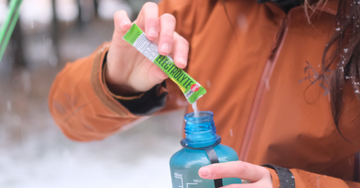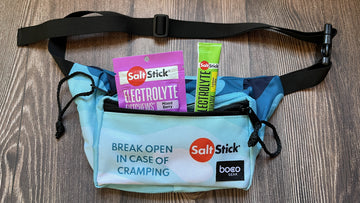Endurance athletes can lose up to 2,000 mg of sodium per hour when they exercise in the heat, but football players may lose much more than that.
The scientific community has conducted extensive research on the hydration practices of endurance athletes, and it is well-understood that long-distance exercise requires a balance of water and electrolytes to maintain performance. Less research, however, exists to show that team sport athletes -- particularly football players -- require similar hydration needs.
The imbalance of information is changing at the academic and elite level, but a lag persists in the broader athletic community. This potentially results in many high school and collegiate football players performing sub-optimally, simply because they are not consuming the nutrition they need to practice for several hours a day in the summer heat.
In this blog, we review the scientific literature to show that while football players lose high levels of sodium during practice, actual mineral intake is often far short of appropriate levels. This not only hampers performance but also can lead to a dangerous condition such as hyponatremia. To learn more, continue reading about sodium and football players below.
Football players sweat a lot
Sweat rates vary widely from individual to individual, and some endurance athletes' sweat can include up to two grams of sodium per hour. Given that the USDA recommends a consumption of just 2,300 mg of sodium for the entire day, this is quite a high rate of sodium loss, especially if the athlete plans to exercise for three hours or more.
This can be quite common when training for a long-distance triathlon or ultramarathon. Football players, however, can lose sodium at much higher levels. In a 2010 Journal of Athletic Training study, researchers Sandra Godek et. al found that some football players can lose up to 30.2 g (that's 30200 mg) of sodium per day! These players practiced an average of 4.5 hours per day, which means their sweat rate can be calculated to more than 6 grams of sodium per hour -- three times as much as the high end of endurance athletes.
The difference is mainly due to increased body mass and high amount of clothing and equipment, which hampers sweat’s ability to evaporate and cool the body, causing athletes to sweat more.
“We agree with other authors who have described the 3.1 g of sodium lost by one soccer player during 90 minutes of training as ‘high’; however, lost more than four times that amount per day,” the authors write.
Another earlier study (also published in the Journal of Athletic Training) found the high end of football players’ sodium loss to be 10 grams per day, but even so, this is much more than what most people consume in their daily diet (average of 3.4 g).
Takeaway: Football players who practice for several hours a day in the heat can lose extremely high levels of sodium -- nearly three times as much as what the average person consumes in their diet.
Football players practice often, and sodium loss is cumulative
If an athlete loses significant amounts of sodium during the day, he or she will likely see some side effects (headache, low energy, fatigue, etc.), but performance may not be significantly hampered at first. However, over the course of several days of intense practice, the imbalance of sodium adds up, and performance can decline in a big way.
To prove this, 2005 Godek et. al published a 2005 study in the American Journal of Sports Medicine, in which they found that college-age football players showed signs of dehydration as soon as the second day of pre-season training that required two practices per day. The signs include low urine volume and low sodium levels in both the blood plasma and urine content.
Takeaway: The authors noted that the study provides “clinical that football players struggle to maintain hydration during preseason twice-a-day sessions.”
Football players do not get enough sodium from their diet
“We should expect that large football players consume salt in excess of what the typical American ingests because they likely consume considerably more calories, and they consume it in response to their substantial sodium losses,” Godek writes in the 2010 study.
Evidence shows otherwise. In 2004, a separate group of researchers sought to examine the dietary habits of collegiate athletes, publishing their results in the International Journal of Sport Nutrition and Exercise Metabolism. The study found that male athletes consumed between 2.5 and 4 grams of sodium per day. While quite a lot for the average population, this level is not adequate for football players who can lose up to 10 grams per day in their practice sessions.
Additionally, the authors also noted that 70 percent of the football players surveyed said they were trying to gain weight, a process that can be hampered without adequate nutrient intake and hydration practices.
Takeaway: Left to their own eating habits, most football players do not consume enough sodium to replace what they are losing on the field.
Sodium supplementation can help ward off dehydration in football players
In 2007, Godek et. al examined collegiate football players who practiced for several hours a day to determine if targeted sodium supplementation could help maintain hydration levels. During the study, the researchers asked the players to consume a solution that contained 4.5 grams of sodium each day. A
fter 10 days, the researchers examined players’ blood sodium and urine levels and saw relatively few signs of dehydration. Two years after that, Godek again studied football players, this time supplementing their diet with 50 percent of the sodium they lost each day, instead of the arbitrary amount of 4.5 grams. At the end of a week of training, the football players again showed no signs of dehydration or inappropriate blood sodium levels.
Takeaway: The bottom line of the two aforementioned studies is that football players can maintain proper hydration levels by supplementing sodium lost through sweat -- and not by relying on diet alone.
Football players need more than just sports drinks
In addition to recognizing the need for sodium supplementation, it is also important to examine the electrolyte source. As Godek and her fellow authors point out, additional sodium cannot come from sports drinks alone. When referencing the player who lost more than 30 grams of sodium in a day, she writes: “Amazingly, replacing 30g of sodium with the average sports drink would require nearly 65 L ; this is not only impractical, but it would add 13,742 calories and 3,848 grams of sugar and would cause hyponatremia.
Clearly, it is improbable that football players who are heavy, salty sweaters can consume this amount of sodium in their diets and so they would require substantial dry sodium supplementation, such as salt tablets or capsules.”
The shortcoming of sports drinks is that they do not contain enough sodium relative to water to maintain the proper ratio of these elements within the body. Sweat typically has about 1,000 mg sodium/liter; however, a typical sports drink has only about 440 mg sodium/liter. If, during the course of competing or training, you ingest nothing but sports drinks (or worse, water), you will become hyponatremic at some point.
Many sports drinks also do not include the other key electrolytes such as magnesium and calcium, potentially causing yet further cramping and muscle issues. Hyponatremia is a dangerous condition that results from blood sodium levels that are too low. Not only does it severely impact performance (resulting in fatigue, weakness, nausea and headache), it also can be deadly.
As Godek writes in her study, hyponatremia was confirmed to be the cause of death for at least one football player in California in 2009. Other examples include a 2008 death in Bakersfield California and a 2014 death in Georgia -- both from hyponatremia-related complications. To learn more about the dangers of hyponatremia, you can read our blog post “These Are the Symptoms (and Causes) of Hyponatremia.”
Takeaway: Sports drinks do not contain enough sodium, relative to the water content they provide. Additional solid sources are required to replace adequate levels of electrolytes.
Conclusion
The training benefits of proper hydration strategies alone should be motivating to any athlete looking to achieve optimal performance. However, consuming adequate sodium levels is also necessary to ward off hyponatremia and its dangerous effects.
SaltStick makes it easy for football players and other athletes to replace these sodium and other electrolytes lost through sweat. SaltStick Caps have been formulated to provide the body with a balanced electrolyte content. Each capsule replaces 215 mg sodium, 63 mg potassium, 22 mg calcium, and 11 mg magnesium -- the ideal to keep all athletes moving, on or off the field. Multiple capsules can be consumed before, during, and after heavy training to ensure suffient electrolyte intake, in combination with proper diet and appropriate fluid intake. Perhaps not surprisingly, several professional football teams have used SaltStick Caps with their players to supplement their sodium intake- with great results!
Learn more about the benefits of SaltStick here.
Disclaimer: Contact your physician before starting any exercise program or if you are taking any medication. Individuals with high blood pressure should also consult their physician prior to taking an electrolyte supplement. Overdose of electrolytes is possible, with symptoms such as vomiting and feeling ill, and care should be taken not to overdose on any electrolyte supplement.









